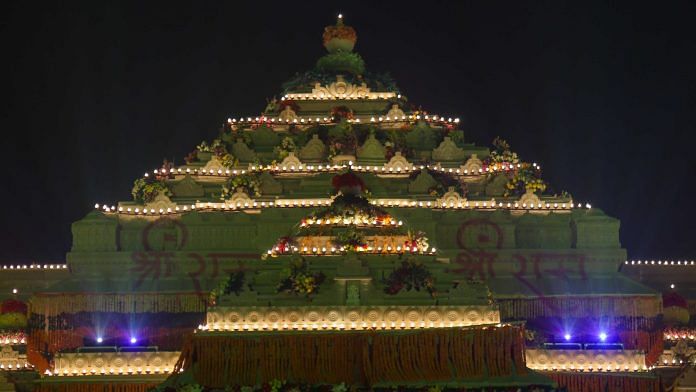Thank you dear subscribers, we are overwhelmed with your response.
Your Turn is a unique section from ThePrint featuring points of view from its subscribers. If you are a subscriber, have a point of view, please send it to us. If not, do subscribe here: https://englishdev.theprint.in/subscribe/
Prana Pratishtha (Consecration) means ‘establishment of life force’ or ‘infusing life’ into something. It is a sacred ceremony where ‘divine essence’ (Prana) is supposed to have been evoked and transfused into an idol of a deity in a temple or at home. It is indeed a divine pleasure that an event awaiting construction of Rama temple at Ayodhya has been excellently performed at partly or fully constructed structure. Lord Rama blesses us to support everyone getting due justice at least now onwards without any social stratification to be a true worshiper, as Rama always honored humane values. Thou shall be keeping a strict vigil on our deeds as his idol has since been infused with divine essence and life. All those in commanding positions must support our Lord in this endeavor without creating any roadblock in any manner. The performers of the said events are bestowed with much higher responsibilities. They may like to rededicate and introspect themselves for the cause of larger humankind and drastically reduce sufferings of the needy, as well off can easily manage their own welfare. They must take a vow to surely honor the ‘promises’ they have made in whatever form to people who have voted them in positions of great status, resources, and capabilities. Then only it would be actual tributes and Bhakti to our Lord, who always stood the ‘Maryada’ test “Prana Jaye Per Vachan Naa Jaye.” Rightly observed that ‘Rama is not a dispute but a solution.’ However, it is possible only if true interpretation of thou’s teachings and noble performances is introspectively done to ensure harmonious co-existence, without using the divine symbol for any personal stake.
- We all are incredibly lucky to see such a great ceremony of our ‘hope’ coming through in our lifetime. Not only construction of elegant temple took place, but also our beloved God’s consecration before our eyes, when two sets of people from Hindu hierarchy performed their respective part of duties, viz.,
2.1 Those (generally from lower strata) who ‘sculpted’ the idol in black granite contrary to tradition of white marble in Northern India, and
2.2 Those who infused ‘Prana’ inside the thus constructed idol (definitely from topmost layer of upper strata).
In the process, it has become clear that humankind can really do wonders in creating and consecrating many things, including symbols of God, if not “God.”
As we explore the significance of consecration, it is essential to understand the rituals involved in this sacred process. The consecration ceremony is not just a formality; it embodies deep spiritual meanings and traditions that have been passed down through generations.
- The way the ceremony was performed, one encouraging aspect has clearly emerged if we look beyond and start hoping positively. It is a turning point in our ancient religious rituals, traditions and understanding to accede to the aspirations of contemporary societal order. It was indeed a great moment that a beloved “OBC” person, generally known as “Shudra,” (till date public domain) for the first time perhaps in Hindu religious history was entrusted with commanding power not only to do ‘Bhoomi Pooja’ but also to perform rituals, including ‘Sankalp’‘ and ‘Pran Pratishtha’ followed by ‘Hawan’ despite opposition and outcry from various sections of public, including the institutions of ‘Shankaracharya ji Maharaj’ on various Vedic connotations like:
3.1 Consecration of idol can be performed only in fully constructed temple, while it is not yet complete,
3.2 Only upper caste Hindus can perform related ceremonies and not a ‘Shudra’ person, who is not permitted even to listen Vedic hymns,
3.3 Such religious ceremonies cannot be performed without a living spouse sitting beside performer,
3.4 No such ceremonies are performed during the month of ‘Poosh’ (lasted till 26 January 2024).
- Consequently, it implies that our Hindu dharma is permitting rationalization of its connotations and started making suitable changes in its traditions. Thus, no one should object Hindu dharma, and everyone must hope beyond to see radical changes in its religious rigidity.
- In mythology, Rama had beheaded Shudra ‘Shambhuka’ who was performing tapas (penance) despite contrary religious connotations. By allowing a ‘Shudra’ person to perform high-level religious ceremonies twice, while a battery of pujaris/pooja performers kept on chanting religious hymns, even Rama has come out clean of such blames. An impressive rationalization of religious mentality supported by high level priests and ‘Shankaracharyas,’ as they did not strongly protest. Seeking tremendous support and financial contribution from OBCs, SCs and STs in demolition of erstwhile Babri Masjid and construction of temple, have been remarkable changes of religious mindset. Hindu Dharma in ‘Kaliyuga’ seems better than what it was in ‘Satya Yuga or Tretha yuga.’
6. Earlier politicians from all strata were taking support and blessings of the religious leaders, but now they are dictating and controlling religious mindset sans any effective resistance. This change has diminished the supremacy of one stratum (Brahmins) in framing rules and controlling decision making on religious matters, as now anyone can rationalize the religious situation according to his/her political wishes. Hope the temple remains without purification/rebuilding.
These pieces are being published as they have been received – they have not been edited/fact-checked by ThePrint.


